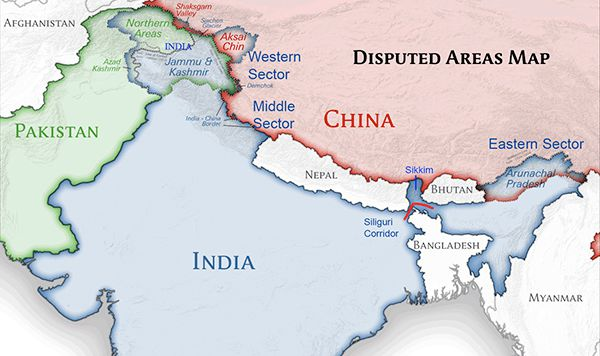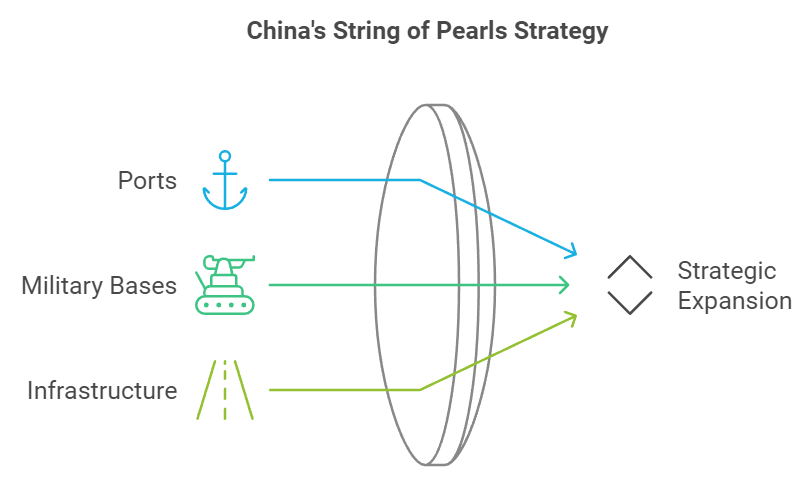Evolving Landscape of India-China Relations | 23 Oct 2024
This editorial is based on “India-China agreement: Breaking a stalemate” which was published in The Indian Express on 23/10/2024. The article brings into picture the recent India-China agreement to restore mutual patrolling rights in Depsang Plains and Demchok, marking the first major breakthrough since the 2020 border crisis. This progress, though limited, comes ahead of the BRICS Summit in Kazan, Russia.
For Prelims: India and China, BRICS Summit , Active Pharmaceutical Ingredients, Electric vehicles, Regional Comprehensive Economic Partnership, Galwan Valley, Line of Actual Control, ASEAN , Brahmaputra, Belt and Road Initiative, String of Pearls, Hambantota Port, Semiconductor Mission, Supply Chain Resilience Initiative.
For Mains: Significance of China for India, Major Areas of Contention Between India and China.
The recent agreement between India and China to restore mutual patrolling rights in Depsang Plains and Demchok in Ladakh marks the first significant breakthrough since the 2020 border crisis. This diplomatic progress, though limited as it focuses only on reversing Chinese transgressions rather than resolving the broader boundary dispute, comes at a strategic time when Indian Prime Minister and Chinese Presidentengaged in their first formal talks in five years on the sidelines of the BRICS summit in Russia..
What is the Significance of China for India?
- Industrial Raw Material Dependency: China has emerged as India's largest trading partner in the FY 2023-24 with USD 118.4 billion two-way commerce (Global Trade Research Initiative), despite border tensions.
- India heavily relies on Chinese imports for critical industrial raw materials and intermediate goods.
- Over 70% of India's Active Pharmaceutical Ingredients (APIs) are sourced from China, making the pharmaceutical industry particularly dependent.
- In the financial year 2023-24, India imported electronic components worth over USD 12 billion from China.
- At present, India depends on imports for nearly 80% of its solar equipment, with China supplying over 60% of these imports (Policy Circle Bureau).
- Recent efforts to establish domestic manufacturing capabilities will take years to significantly reduce this dependency.
- Technology and Digital Infrastructure: Despite security concerns and app bans, Chinese technology continues to influence India's digital landscape.
- Chinese smartphone manufacturers still dominate the Indian market with over 75% market share collectively (Counterpoint Research).
- Critical telecommunications equipment, despite restrictions, often has Chinese components or technology. India's emerging sectors like electric vehicles significantly depend on Chinese battery technology and components.
- Investment and Expertise: Chinese technical expertise remains valuable for Indian industrial development. Chinese companies have significant experience in infrastructure development and high-speed rail systems, which India seeks to develop.
- Several Indian unicorn startups have received substantial Chinese investments, crucial for their growth phases.
- As of 2020, 18 Unicorn companies in India had over USD 3,500 million of Chinese investments
- Several Indian unicorn startups have received substantial Chinese investments, crucial for their growth phases.
- Trade Route Dependency: India's trade routes and regional connectivity initiatives often intersect with Chinese influence.
- Many of India's trading partners in Southeast Asia have strong economic ties with China. The Regional Comprehensive Economic Partnership (RCEP), though India opted out, shows China's significant role in regional trade architecture.
- Over 55% of India's trade passes through the South China Sea and Malacca Straits. (Ministry of External Affairs)
- Maritime trade routes crucial for India's commerce pass through regions where China has significant presence.
- Many of India's trading partners in Southeast Asia have strong economic ties with China. The Regional Comprehensive Economic Partnership (RCEP), though India opted out, shows China's significant role in regional trade architecture.
What are the Major Areas of Contention Between India and China?
- Border Disputes and Territorial Claims: The 3,488-km Line of Actual Control (LAC) remains the most volatile flashpoint, with frequent standoffs and incidents.
- The Indian and Chinese militaries have been locked in a standoff since May 2020 following the fierce clash in the Galwan Valley
- China currently occupies approximately 38,000 sq km in Aksai Chin and claims 90,000 sq km of Arunachal Pradesh (which it calls South Tibet). (Ministry of External Affairs)
- Recent satellite imagery shows China constructing dual-use villages along the LAC and significant military infrastructure upgrades.
- Economic Imbalances and Trade Deficit: India faces a massive trade deficit with China, reaching $85 billion in 2024 according to a report published in The Hindu.
- Over the past 5 years the exports of China to India have increased at an annualized rate of 9.61%. (The Observatory of Economic Complexity)
- India has implemented anti-dumping measures against Chinese products but still China has consistently made backdoor entry into India through ASEAN intra-trade and bilateral FTAs.
- Water Resource Disputes: China controls the upstream regions of major rivers flowing into India, including the Brahmaputra (Yarlung Tsangpo).
- China has constructed multiple dams, including the massive Zangmu Dam near the Bhutan-India border and plans for the world's largest hydroelectric project at Medog.
- There's no water-sharing treaty between the two countries, and following the Doklam standoff on the border of India and China in 2017, China stopped releasing hydrological data on the Brahmaputra.
- Cyber Threats: China has been in the spotlight for cyber attacks in India. In 2022, China-linked hackers reportedly targeted seven Indian power hubs.
- Over 300 Chinese apps have been banned since 2020. Concerns over 5G technology led to the effective exclusion of Huawei and ZTE from India's telecom infrastructure.
- A recent report by SentinelOne claims that the 2022 ransomware attack on AIIMS Delhi was orchestrated by the Chinese threat actor group ChamelGang.
- Regional Influence Competition: China's Belt and Road Initiative investments exceed USD 62 billion in Pakistan (CPEC) alone, challenging India's regional influence.
- China has established bases or port facilities in Pakistan, Sri Lanka, Myanmar and Maldives. Also, Chinese economic influence in Nepal, Bhutan and Bangladesh has grown significantly, creating a "String of Pearls" around India.
- India's counter-initiatives, including the Necklace of Diamonds strategy, are still in their early stages.
- Strategic Alliances and Regional Partnerships: China's deep military cooperation with Pakistan, including sharing of nuclear technology and defense equipment concerns India.
- India's growing alignment with the US and especially QUAD (including joint military exercises like Malabar) has antagonized China.
- India's oil exploration projects in Vietnam's EEZ face Chinese opposition.
- Approximately $200 billion of India's trade passes through the South China Sea annually. (Observer Research Foundation)
- China's expanding naval presence in the Indian Ocean, including submarine deployments and research vessels like in Hambantota Port, concerns India.
- Diplomatic and International Forums: China's continued protection of Pakistan-based terrorists at UN forums frustrates India.
- Competition for influence in international organizations like SCO and BRICS creates tensions. China's opposition to India's role in global governance reforms continues.
- Chinese opposition to India's NSG membership and UNSC permanent seat aspirations continues.
What Measures can India Adopt to Balance its Relations with China?
- Economic Diversification and Self-Reliance: India should continue expanding its PLI scheme to reduce critical sector dependencies.
- Focus on developing domestic manufacturing capabilities in key areas like APIs, electronics, and solar equipment through initiatives like Semiconductor Mission (USD 10 billion investment).
- Foster partnerships with countries like Japan, South Korea, and EU nations for technology transfer and investment in critical sectors.
- Strengthen MSME sector to develop local supply chains and reduce import dependency.
- Implement smart protectionist measures while maintaining WTO compliance.
- Develop quality standards and certification processes to manage imports. Create incentives for domestic value addition in manufacturing.
- Strategic Military Modernization: Accelerate military infrastructure development along the LAC, including 73 strategic roads and advanced landing grounds.
- Enhance surveillance capabilities through satellite and drone technology, following October 2024 procurement of 31 Predator drones.
- Strengthen mountain warfare capabilities through specialized training and equipment acquisition. Develop quick reaction forces and improve logistics capabilities in border areas.
- Regional Leadership Enhancement: Strengthen partnerships with neighboring countries through increased development assistance and infrastructure projects.
- Expand initiatives like BIMSTEC and Indian Ocean Rim Association to counter BRI influence.
- Develop alternative supply chain networks through initiatives like Supply Chain Resilience Initiative with Japan and Australia. Increase cultural and educational exchanges with Southeast Asian nations.
- Diplomatic Engagement Strategy: Maintain dialogue through multiple channels while standing firm on core interests.
- Engage in multilateral forums like SCO and BRICS while strengthening QUAD partnerships. Develop issue-based coalitions with like-minded countries on specific challenges. Balance relationship with US, China and Russia to maintain strategic autonomy.
- Recent examples include successful management of border tensions through diplomatic channels while maintaining trade relations.
- Economic Leverage Development: Identify and utilize Indian market strengths in negotiations with China.
- Develop alternative markets for Indian exports through FTAs with the UK and EU.
- Create policy frameworks to screen investments while maintaining beneficial economic ties. Strengthen India's position in global supply chains through initiatives like PM Gati Shakti.
- Recent success includes redirection of some global supply chains to India under China+1 strategy and through decoupling initiatives.
- Maritime Strategy Enhancement: Strengthen naval capabilities and presence in the Indian Ocean Region.
- Accelerate development of port infrastructure and connectivity through the Sagarmala Project.
- Enhance maritime cooperation with QUAD and ASEAN nations. Improve surveillance and monitoring capabilities in strategic waterways like Arabian Sea.
Conclusion:
The recent agreement between India and China to restore mutual patrolling rights in Depsang Plains and Demchok is a positive step towards stabilizing the fragile border situation. India must continue to pursue a multifaceted strategy that combines economic diversification, military modernization, regional leadership, and diplomatic engagement to balance its relations with China.
|
Drishti Mains Question: The India-China relationship is characterized by both cooperation and confrontation. Discuss in reference to how economic interdependence influences India's foreign policy decisions in the Indo-Pacific region. |
UPSC Civil Services Examination Previous Year Question (PYQ)
Prelims
Q. “Belt and Road Initiative” is sometimes mentioned in the news in the context of the affairs of : (2016)
(a) African Union
(b) Brazil
(c) European Union
(d) China
Ans: D
Mains
Q. The China-Pakistan Economic Corridor (CPEC) is viewed as a cardinal subset of China’s larger ‘One Belt One Road’ initiative. Give a brief description of CPEC and enumerate the reasons why India has distanced itself from the same. (2018)


